This blog post is a continuation of a three part series covering the research process and stories related to eight Black Indiana University Bloomington students who were required to travel from Bloomington to Indianapolis to complete their required student teaching at the then-segregated Crispus Attucks High School (see the previous post here).
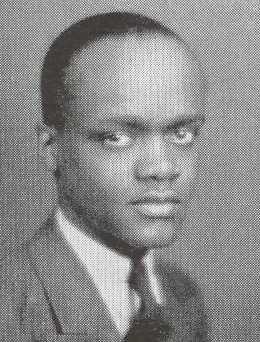
Nathaniel Louis Sayles, 1914-1969
AB English ’35; AM English ’49
Nathaniel Louis Sayles was born in Memphis, Tennessee and graduated from high school in Gary, Indiana. He attended Gary College and transferred to Indiana University Bloomington in 1934 where he studied English. While at IU, he lived in the Kappa Alpha Psi house and was active in the fraternity’s events and roundtable discussions about race on campus.
(Nathaniel Sayles, Arbutus yearbook, 1935. IU Archives image no. P0111158)
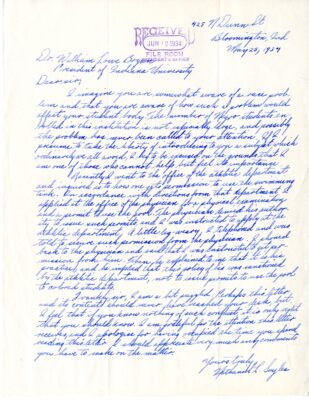
For example, in 1934, Nathaniel wrote a letter to then-IU President William Lowe Bryan about the segregation of the swimming pool on campus. He wrote that Black students were required to get physical examinations to use the pool, but several physicians refused to see him (a transcript of the letter is included in the image description).
Nathaniel attended IU with the support of federal aid programs such as the Civil Works Administration, Federal Emergency Relief Administration, and National Youth Administration which aimed to support student education during the Great Depression. These programs can have a loose comparison to a student being offered the Pell Grant and being on Work Study today. Nathaniel worked for Henry Holland Carter, head of the English Department.
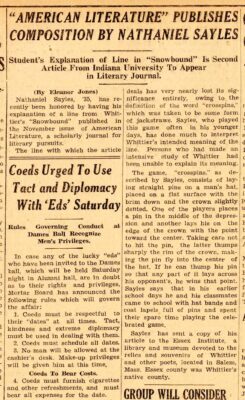
In November of 1934, Nathaniel published an article in the scholarly literature journal American Literature, which was a major accomplishment for an undergraduate. The achievement was covered by the Indiana Daily Student.
To continue his education upon graduation, Nathaniel was offered a scholarship from the Language Club to cover the cost of graduate school. He received multiple letters of support from IU faculty in the English department citing his great work as a student and future promise.
Quotes from English Department faculty members:
“Sayles did good work for me in American Literature and, as you probably know, published one short note on Whittier’s “Snow Bound” in American Literature for November 1934. I believe in him. I think a loan to him would be an investment in a good cause.” – Frank Daridam
“I am very glad indeed to hear that there is a possibility of helping Mr. Sayles to continue his studies here. In fact, he is one of the most promising students I have ever had, and I should think it most unfortunate if he were not able to have graduate training. In addition to being gifted, he gives every evidence of being a young man of extremely fine character.” – Grace Nealy Martin
Unfortunately, Nathaniel had to decline the loan as he had an outstanding debt to the IU bursar and needed to work to cover those costs rather than continue school full time. He was awarded his Bachelor of Arts degree in 1935, and walked at IU’s 1936 commencement ceremony. Later in life he returned to IU to complete his Masters of Arts in English in 1949.
Nathaniel worked in the Gary School District as a teacher where he met and then married Etta Virginia Sayles. He was often included in community forums and panels discussing Black education and civil rights. Nathaniel passed away at the age of 55 in Gary, Indiana.
George Pickett Porter, 1900-1983
BA Chemistry ’35
George Pickett Porter was born in Columbia, Tennessee and entered Indiana University in 1923 as a chemistry major, though he only completed one year of school. He married Mildred Smith and moved to Indianapolis where he returned to school and completed his degree in 1935.
(George Porter, Arbutus yearbook, 1935. IU Archives image no. P0111156)

While at IU, George was a member of Kappa Alpha Psi fraternity (similar to two other students included in this blog post series, Nathaniel Sayles, Virgil Clift, and George Wade). George and Mildred had three children and he worked as a chauffer in Indianapolis for 41 years. Later in life, he remained active in the Indianapolis’ Kappa Alpha Psi fraternity, his local NAACP, Light Housekeeper Club, the Sunday Afternoon Supper club, and was a trustee of his church.

Evelyn Marshall White, 1915-1936
BA Chemistry ’36
Evelyn White was born in Louisville, Kentucky and earned her Bachelor of Arts with a major in Chemistry in spring 1936.
Evelyn was an active IU student, being involved in the Euclidean Circle, Women’s Athletic Association, Cosmopolitan Club, International Relations Club, and Delta Sigma Theta sorority. Sadly while we have record that Evelyn graduated and was sent her degree, a letter from her Mom Queenie in 1936 shared that their home flooded and Evelyn passed away from bronchitis shortly after.

Ernest Franklin Stevenson, 1912-2001
BA Chemistry ’36; MA ’37
Ernest Stevenson was born in Newark, Delaware where he graduated from New London Avenue Public School with advanced standing. Ernest started his undergraduate degree at IU in 1931, studying chemistry. As a student he was an active member of the fraternity Alpha Phi Alpha, an interracial club, and enjoyed playing baseball and softball.
(Ernest Stevenson, Arbutus yearbook, 1935. IU Archives image no. P0111160)
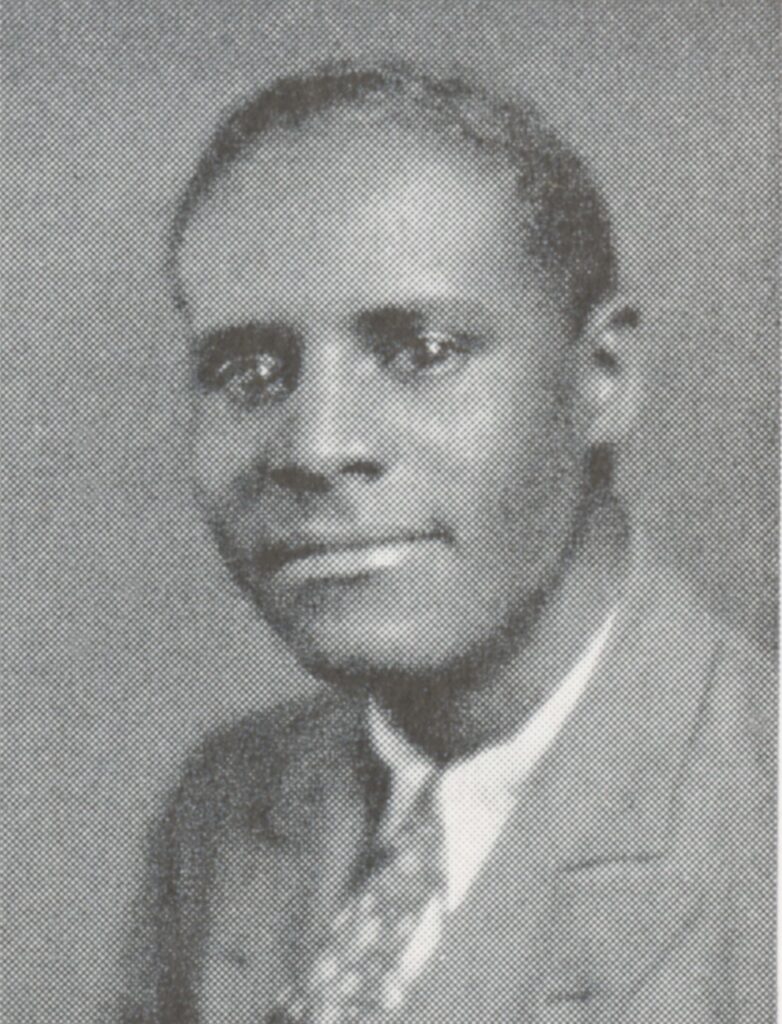
Directly after his graduation, he continued his studies in Chemistry at IU and completed the thesis Aluminum salts instead of iron salts in testing for acetates. In 1938, Ernest married Henrietta Roberts and they had two children. He worked first as first as a research chemist for the Worne Plastics Corporation and went on to a position as an analytical chemist at the Eclipse Pioneer Division of the Bendix Aviation Corporation in Bendix, New Jersey which supported aviation initiatives in WWII and the Korean War.
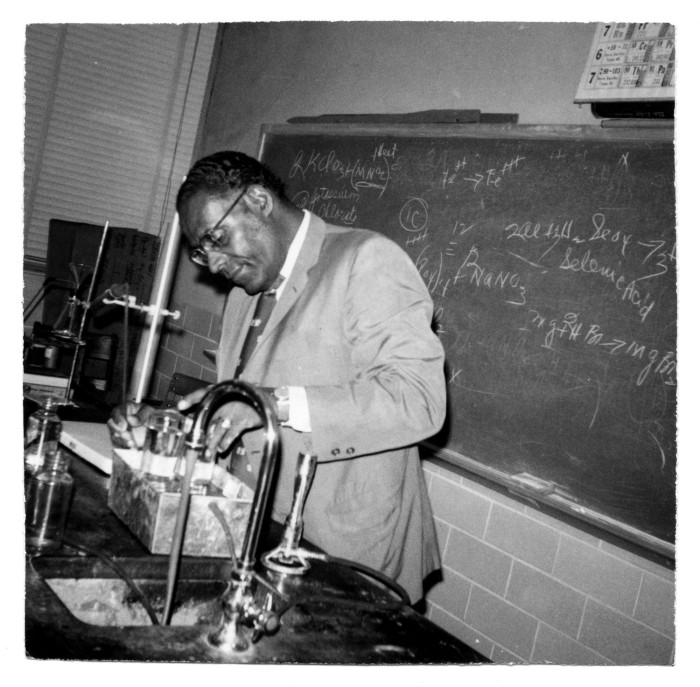
Ernest later became a chemistry professor and taught at Sam Houston College, College of Upper New York, Mohawk College at Utica, Champlain College, and finally, Saint Philips College where he was the head of the chemistry department (picture to the left). He also conducted research at the Gordon Research Laboratories and furthered his education at the Massachusetts Institute of Technology (MIT) and the Oak Ridge Institute of Nuclear Studies.
Ernest retired in 1982 and became active in church life as he was ordained as a Ruling Elder at Elmwood Presbyterian Church in East Orange, New Jersey and later San Antonio in 1971. He also served as Scoutmaster for his son’s Cub and Boy Scout Troupe. Ernest remained active in Alpha Phi Alpha and became a member of the Delta Rho Lambda Chapter. For the remainder of his life, he was active in San Antonio’s NAACP and continued fighting for racial equity.
Leave a Reply